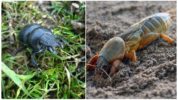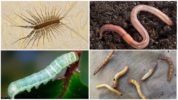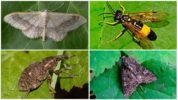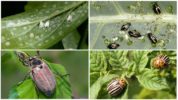- Melon aphid and spider mite
- Bear and shear beetle
- Garden pests
- Garden pests
- Garden pests
To save the crop, you should know exactly what beetles are pests of the garden. Some of them are able to deprive a plot of all green mass in a matter of days. The list of the most famous parasites, photos and names of pest beetles will help save time and take preventive measures against the invasion of such insects in the future.
The enemy must know in person
Different types of insects constantly attack plantings in garden and garden plots, and only effective control of them can help save the crop. In addition, many insects - pests of the garden and garden over time develop immunity to the used pesticides and drugs. Therefore, the methods of dealing with them have to be changed.
The photos below of insects of garden and garden pests will help to accurately identify them and take timely measures to save the vegetation. According to the way of life and nutrition, garden pests are divided into several groups:
- larvae and beetles living in the ground: shear, bear, caterpillar of butterflies, mealybugs, larvae of wireworms, grubbers, etc.
- the flying pests of the garden include the Colorado potato beetles, whiteflies, moths, sawflies, leafworms, May dodgers, scoops, weevils, etc .;
Below are descriptions of the most common harmful insects in the garden.
Aphids
Numerous placers of tiny green or black aphid bugs can destroy many plantings of vegetable and berry crops.
Important!
Settled aphids colonies. Feeding exclusively on plant sap, which they suck from young shoots, they poison plants with injected poison and can transmit infections and viruses. In the absence of timely measures to destroy aphids, it is able to completely destroy most of the crop.
Methods fight aphids conducted in several ways:
- mechanical, flushing insects with a stream of water;
- with help solution of wood ash and soapdecoctions of medicinal and other plants (tansy, yarrow, garlic, dandelion, tobacco, etc.);
- the destruction of ant settlementsthat become aphids;
- chemical insecticides.
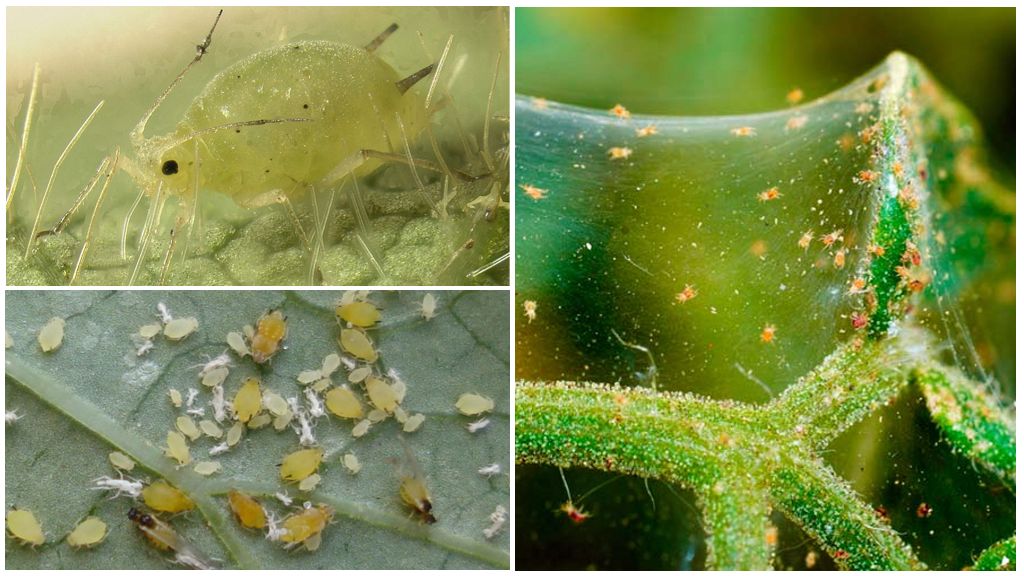
Spider mite
The invasion of small red bugs in the garden in the ground or on the leaves of fruit trees means the appearance on the garden plot spider mites. The main diet of their diet consists of plant juices, which they draw from leaves and young shoots. The result of parasitization is spoiled parts of plants covered with a thin white cobweb.
The size of red ticks is not more than 1 mm, but they live in large colonies and are capable of causing noticeable harm to garden crops. The leaves begin to stain, turn yellow, the plant weakens greatly and suffers from a lack of chlorophyll.
In the fight against insects, garden pests in this situation are helped by treatment with a soap solution, garlic or onion infusion. As insecticides, insecticides (Actellik, Neoron) and biological products (Fitoverm and others) are used.
Medvedka
One of the largest garden pest insects living underground the little bears. They have a large body (up to 6 cm long) of a dark brown color, equipped with digging front legs. Able to prune all underground parts of garden crops, including potato tubers and tree roots.
On a note!
Such brown beetles in the country prefer to settle in moist, well-fertilized humus soils.
Gardeners over the years have developed several methods of dealing with bearswhich include: deep tillage (at least 15 cm in spring and autumn), the construction of hunting pits (diameter 30 cm, depth up to 79 cm) with manure, planting plants in glasses, as well as biological (Metarizin) and chemicals.
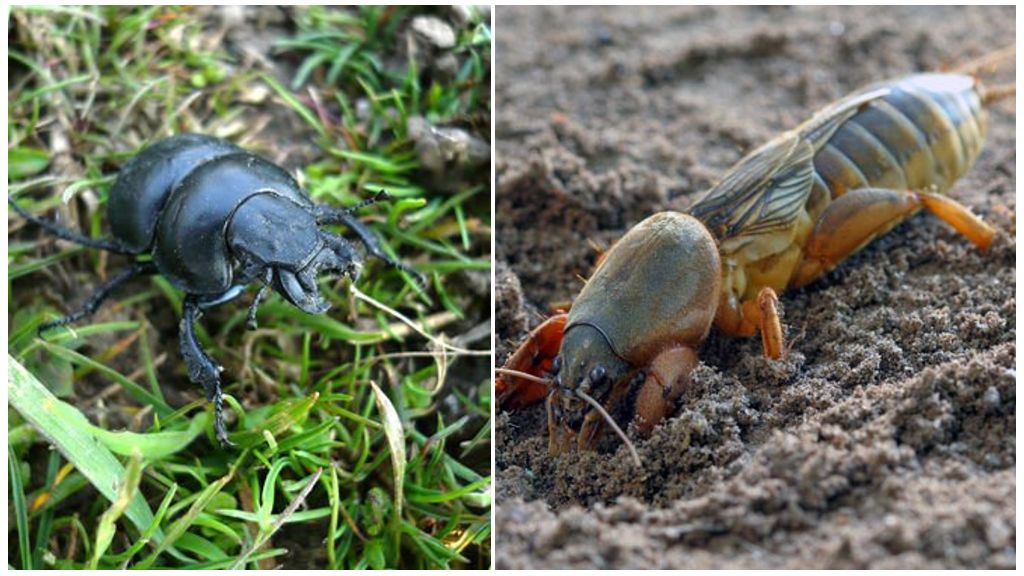
Sheaf beetle
One of the common pests is a large black beetle in the garden or strigun (scrub). It is painted black, body size is several centimeters, lives in underground burrows and has a hard shell, which is why even birds cannot eat it.
On a note!
Black ground beetles usually appear in early spring, cutting off the first weed shoots. After emergence in the garden, pests are accepted for them. Strings able to quickly destroy all planted seedlings of garden crops, not even disdaining garlic and onions.
To combat the earthen beetle, gardeners use various folk methods, from manual collection to digging trenches and installing metal profiles around the perimeter of the garden.
Usually in early June, these black long beetles already finish their destructive activity, burrowing deep underground and laying eggs to provide for their offspring. Therefore, only a deep digging of the earth in autumn can help to destroy pests, during which the larvae that come to the surface freeze and die.
Other earthen pests
Most often, the roots of garden and berry crops that eat various insects or their larvae living in the soil suffer from underground pests:
- millipedes - small individuals, breed in compost heaps, eat flower bulbs, strawberry fruits, a strong population growth is observed with high humidity;
- earthworms and earthworms - although they benefit by digging the top layer of soil, they negatively affect the adhesion of roots and earth, from which plants can be drawn underground;
- caterpillar scoop (winter and exclamation) - in the spring months they live underground and eat roots of vegetable crops, preferring cabbage, carrots and seedlings of decorative flowers, also nibble leaves and root crops;
- wireworm larvae (striped nutcracker or bread) - attack vegetables, planting strawberries and wild strawberries, eating small roots and larger roots, damaging root crops and flower bulbs;
- beetle larvae - live for several years in the soil, feeding on the underground parts of plants (vegetables, shrubs and fruit trees);
- foottails - white jumping insects settle in the ground near garden and domestic plants.
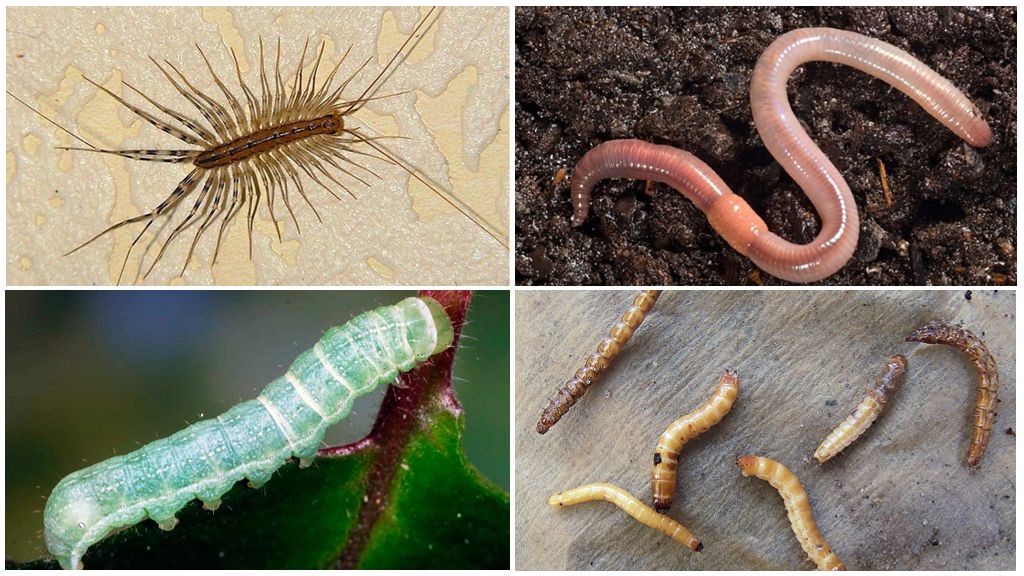
On a note!
To combat these pests, they use both folk methods (decoctions of wormwood, tomato tops, bleached), and chemical preparations (Talstar, Tsiktor).
Flying insect pests
Most popular garden pest beetles:
- sawfly - an insect that looks like a small fly eats up leaves and weaves a web of nests among trees (apricot, cherry, etc.) and shrubs; chemical preparations are used for destruction;
- weevil - parasitizes on raspberries and strawberries, larvae appear from laid eggs, which gnaw buds and eat plant stalks, live right in the flowers;
- moth - the danger is a small caterpillar that moves with the help of squeezing-unclenching the body, attacks young shoots, sucks all plant juices out of them, uses special traps and chemical treatment against it, and the birds that feed on them help;
- scoop - a nocturnal butterfly eating all parts of plants; one of the popular methods of combating a scoop is to plant wormwood, as well as insecticides;
- mealy and root mealybug - such white insects live on the stems and leaves of garden crops and ornamental flowers, feed on plant juices;
- thrips - black bugs in the ground at the cottage or in the garden, hide under the leaves, a silver coating appears on the leaves of the affected plants;
- gooseberry - a small butterfly that lays eggs during the period of berry formation, after the hatched larvae begin to entangle with a web of berries and fruits on the trees;
- leaf beetles and rattles - light brown or light brown flying beetles up to 1 cm in size, feed on leaves, buds, flowers and stems of garden and ornamental plants;
- blue beetles in the garden - this is most often an alder leaf beetle, the food base for which is an alder, or a spinach beetle, gnawing leaves of trees, potatoes;
- meadow moth - lays eggs on plants, and hatched larvae begin to quickly eat leaves, ovaries and even tree bark, they damage the fruits and seeds of plants.
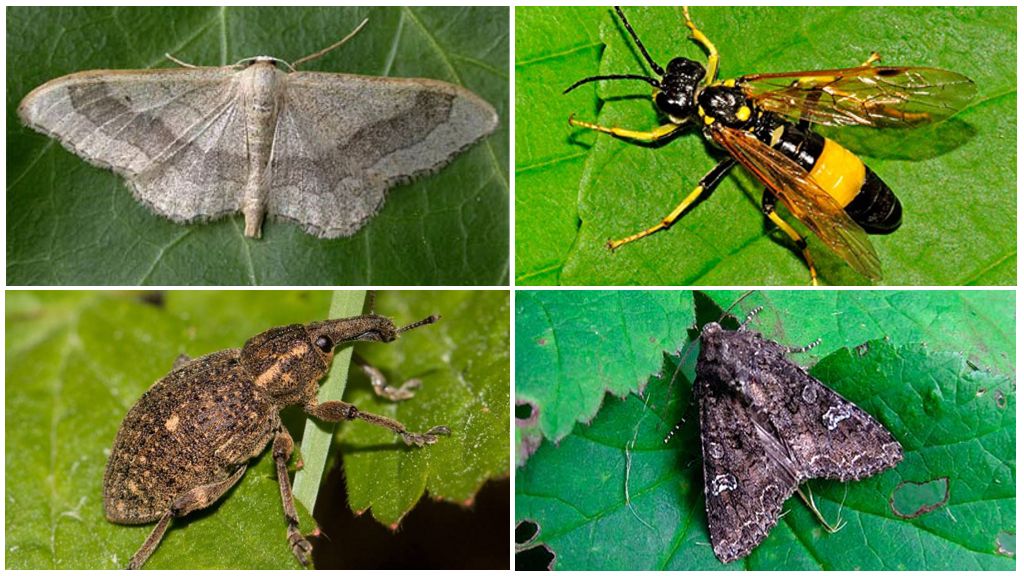
To combat these pests, it is recommended to use folk remedies (decoctions of tomato tops, tansy, wormwood, capsicum, garlic shooter, etc.) and insecticides: Corado, Alatar, Spark, Commander, Fury, Kinmix et al.
Whitefly
This pest looks like a white-yellow small butterfly with a waxy plaque on its wings, which loves to feast on various vegetables: pumpkin, cucumbers, zucchini, etc.
Their larvae have a light green color and an oval body, covered with a pile or thread. Females lay eggs on the back of the leaf plates.
On a note!
After emergence, the larvae begin to actively suck plant juice and excrete excrement. As a result of the action of such harmful insects in the garden, soot fungus appears on the leaves, which can lead to the death of the plant.
For effective whitefly control apply chemical agents: Actofit, Vermicid, etc.
Fleas
Miniature bugs, almost invisible on the leaves of cabbage, radish and other garden crops, can cause significant harm. They gnaw holes in leaves and heads of cabbage. Fleas look like small black beetles in a garden a few millimeters in size. To combat fleas, spraying garden crops with tinctures of onions and garlic, tomato leaves, etc. in a soap solution is used.
Colorado beetle
Adults stand out for their orange-yellow-black color. The biggest harm is done by their larvae colorado beetlesthat are able to completely eat leaves and stems of garden plants for several days.
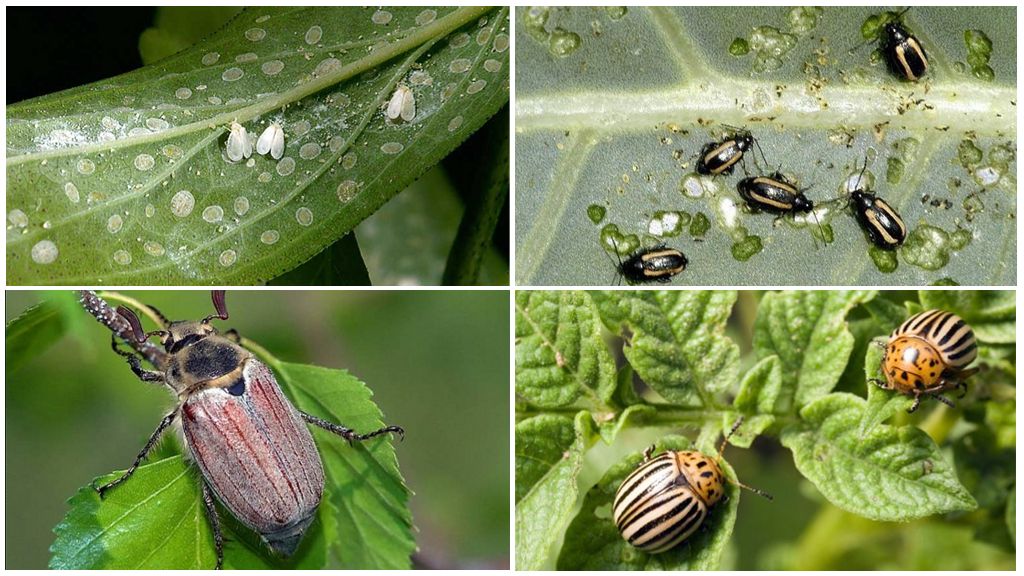
Interesting!
Over the past 10 years, these striped guests from the American continent have become the worst pests of plantings of all garden crops, and especially plants of the nightshade family (potatoes, eggplant, tomatoes and peppers).
Therefore, at the first signs of the appearance of "Colorado" urgent measures should be taken. You can collect parasites manually. However, it is more effective to treat plantings using chemical insecticides: Actofit, Coloradocide, etc.
Chafer
Bright green and blue bugs got their name by the month when they begin to fly actively. The size Khrushchev is up to 3 cm. It is in May and June that the khrushchis begin to fly out after the females have managed to lay eggs in the ground with the future offspring.
On a note!
Pests are beetle larvae, the size of which can reach 6.5 cm, which eat up the underground parts of plants.
Against larvae, both folk remedies (infusions and decoctions of herbs), as well as biological products (Nemabakt) and chemical insecticides (Antichrush, Pochin, Bazudin, etc.) are used.
The listed species make up only a small part of the insect pests, actively destroying garden and garden crops both in the underground and in the aboveground. The number of parasites that feed on various parts of plants is quite numerous. Therefore, to effectively control them, you should carefully study the list of pests, fight them in a timely manner, which will help preserve the harvest of vegetables, fruit and berry crops in the garden.

